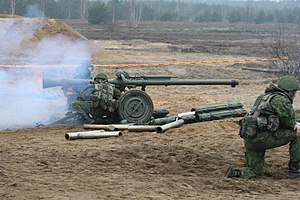|
Pansarvärnspjäs 1110
The Pansarvärnspjäs 1110 (Pvpj 1110), is a Swedish 90 mm recoilless gun also widely known as Pv-1110 or the "Stovepipe" (Kaminrör). It entered service in the early 1960s and was phased out of service in the Swedish Army in the late 1990s after 1,600 had been produced. Some 300 weapons were transferred to Estonia, Latvia and Lithuania. The Pvpj 1100 was typically towed by, or mounted on a Pansarvärnspjästerrängbil 9031 Volvo truck. From the late 1970s it has also been mounted on the Terrängbil 11 and the Bandvagn 2062 tracked carrier. For Arctic warfare it could also be fitted to a pulka and pulled by two skiers. The Pvpj 1110 is fitted with an optical sight and has an iron sight as backup. A modified Ag m/42 rifle with matching trajectory is used as ranging gun under the designation Inskjutningsgevär 5110. The type was used by the Irish Army in towed form, and was experimentally fitted to the chassis of an A34 Comet Tank in place of the turret after the tank had been damaged by a fire in 1962 which destroyed the turret. The Comet tank with the Pvpj 1110 became known as “The Headless Coachman”.[1] The Pvpj 1110 have been seen in use by the Ukrainian army during the Russo-Ukrainian War.[2] AmmunitionThe Pvpj 1110 is designed to fire fixed-fin stabilised HEAT rounds with tracers. The Swedish designation for these rounds are spårljuspansarspränggranat (slpsgr), literally translated into traced armor-blowing shell, or armor-defeating explosive shell with tracer.[3] The ammunition consists of a projectile inserted into a patronhylsa m/59 brass casing to form a complete cartridge with its own projectile-specific designation.
During the development of the Infanterikanonvagn 91, the same projectiles would be used, although with different cases, to form the ammunition for the low-pressure main gun. This newly designed gun was not recoilless, and as such necessitated cases with a regular case bottom as opposed to the blow-out recoilless design of the patronhylsa m/59 case. Users
See also
References
External links
|
||||||||||||||||||||||||||||||||||||||||||||||||||||
